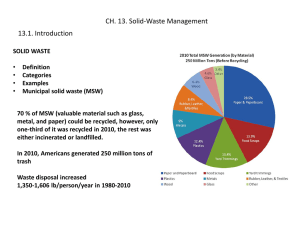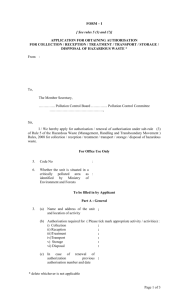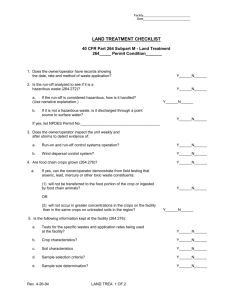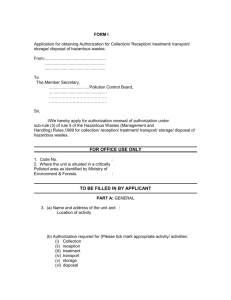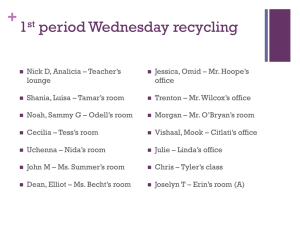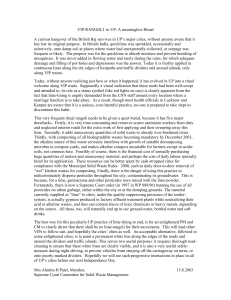Waste Management: Methods, Landfills, Recycling & Hazardous Waste
advertisement
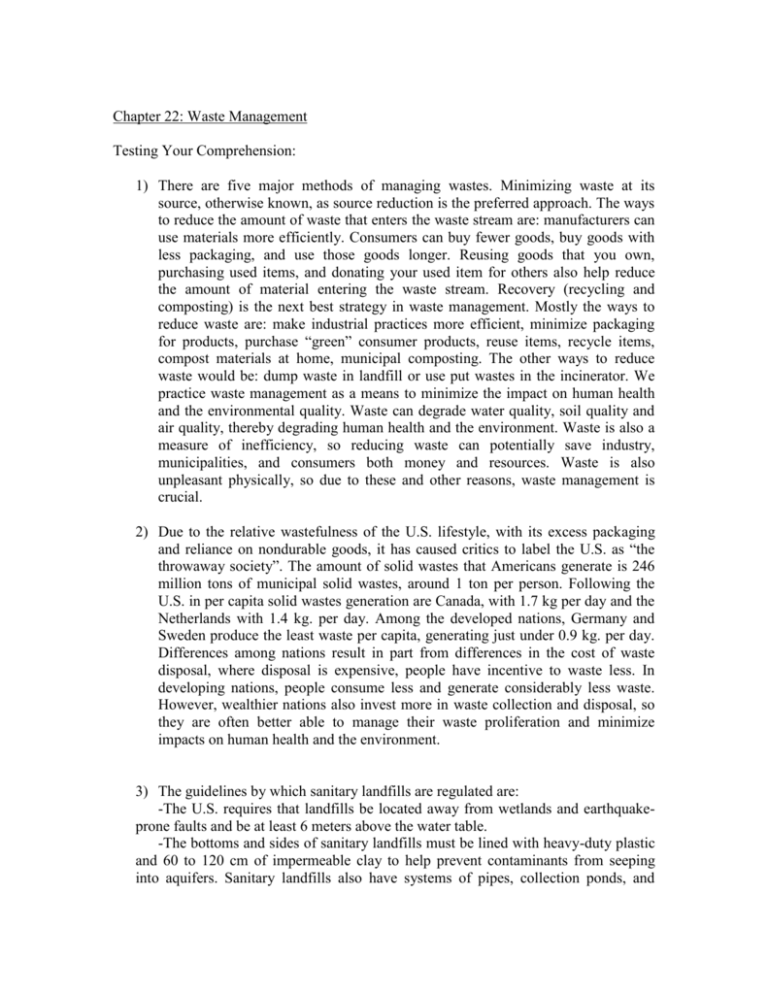
Chapter 22: Waste Management Testing Your Comprehension: 1) There are five major methods of managing wastes. Minimizing waste at its source, otherwise known, as source reduction is the preferred approach. The ways to reduce the amount of waste that enters the waste stream are: manufacturers can use materials more efficiently. Consumers can buy fewer goods, buy goods with less packaging, and use those goods longer. Reusing goods that you own, purchasing used items, and donating your used item for others also help reduce the amount of material entering the waste stream. Recovery (recycling and composting) is the next best strategy in waste management. Mostly the ways to reduce waste are: make industrial practices more efficient, minimize packaging for products, purchase “green” consumer products, reuse items, recycle items, compost materials at home, municipal composting. The other ways to reduce waste would be: dump waste in landfill or use put wastes in the incinerator. We practice waste management as a means to minimize the impact on human health and the environmental quality. Waste can degrade water quality, soil quality and air quality, thereby degrading human health and the environment. Waste is also a measure of inefficiency, so reducing waste can potentially save industry, municipalities, and consumers both money and resources. Waste is also unpleasant physically, so due to these and other reasons, waste management is crucial. 2) Due to the relative wastefulness of the U.S. lifestyle, with its excess packaging and reliance on nondurable goods, it has caused critics to label the U.S. as “the throwaway society”. The amount of solid wastes that Americans generate is 246 million tons of municipal solid wastes, around 1 ton per person. Following the U.S. in per capita solid wastes generation are Canada, with 1.7 kg per day and the Netherlands with 1.4 kg. per day. Among the developed nations, Germany and Sweden produce the least waste per capita, generating just under 0.9 kg. per day. Differences among nations result in part from differences in the cost of waste disposal, where disposal is expensive, people have incentive to waste less. In developing nations, people consume less and generate considerably less waste. However, wealthier nations also invest more in waste collection and disposal, so they are often better able to manage their waste proliferation and minimize impacts on human health and the environment. 3) The guidelines by which sanitary landfills are regulated are: -The U.S. requires that landfills be located away from wetlands and earthquakeprone faults and be at least 6 meters above the water table. -The bottoms and sides of sanitary landfills must be lined with heavy-duty plastic and 60 to 120 cm of impermeable clay to help prevent contaminants from seeping into aquifers. Sanitary landfills also have systems of pipes, collection ponds, and treatment facilities to collect and treat leachate, liquid that results when substances from the trash dissolve in water as rainwater percolates downward. -Landfill managers are required to maintain leachate collection systems for 30 years after a landfill has closed. -Area groundwater has to be monitored regularly for contamination. -After a landfill is closed, it should be capped with an engineered cover that must be maintained. This cap should consist of a hydraulic barrier of plastic that prevents water from seeping down and gas from seeping up, a gravel layer above the hydraulic barrier that drains water, lessening pressure on the hydraulic barrier; a soil barrier of at least 60 cm. that stores water and protects the hydraulic layer from weather extremes, and a topsoil layer of least 15 cm. that encourages plant growth, helping to prevent erosion. Three problems with landfills are: -The leachate will eventually escape even from well-lined landfills. Liners can be punctured and leachate collection systems eventually cease to be maintained. -Landfills are kept dry to reduce leachate, but the bacteria that break down material thrive in wet conditions. Dryness, therefore, slows waste decomposition. -Being able to find suitable areas to locate landfills because most communities do not want them. Most communities reject the idea of having landfills near their housing areas, since landfills pose many problems with human health and sanitation. 4) The process of incineration/combustion is a controlled process in which mixed garbage is burned at very high temperatures. At incineration facilities, waste is generally sorted and metals removed. Metal-free waste is chopped into small pieces to aid combustion and then is burned in a furnace. Incinerators reduce the volume of solid waste by burning it but may emit toxic compounds into the air. Many incinerators are waste-to-energy facilities that use the heat of combustion to generate electricity. In a waste-to-energy facility, waste is (one), burned at extremely high temperatures, (two), heating water, which turns to steam. The steam turns a turbine (three) which powers a generator to create electricity. In an incinerator outfitted with pollution-control technology, toxic gases produced by combustion are mitigated chemically by a scrubber, (four) and airborne particulate matter is filtered physically in a baghouse, (five) before air is emitted from the stack. (six) Ash remaining from the combustion process is disposed of (seven) in a landfill. The resulting ash is then thrown in a landfill. One drawback of incineration is that revenues from power generation are usually not enough to offset the considerable financial costs of building and running incinerators. It can take many years for a wasteto-energy facility to become profitable, since many companies that build and operate these facilities require communities contracting with them to guarantee the facility a minimum amount of garbage. 5) Composting is the conversion of organic waste into mulch or humus through natural biological processes of decomposition. The compost can then be used to enrich soil. Householders can place waste in compost piles, underground pits, or specially constructed containers. As wastes are added, heat from microbial action builds in the interior, and decomposition proceeds. Banana peels, coffee grounds, grass clipping, autumn leaves, and countless other organic items can be converted into rich, high quality compost through the actions of earthworms, bacteria, soil mites, sow bugs, and other detritivores and decomposers. Home composting is a prime example of how we can live more sustainably by mimicking natural cycles and incorporating into our daily lives. Municipal composting programs divert food and yard waste from the waste stream to central composting facilities, where they decompose into mulch that community residents can use for gardens and landscaping. Composting reduces landfill wastes, enriches soil and helps it resist erosion, encourages soil biodiversity, makes for healthier plants and more pleasing gardens, and reduces the need for chemical fertilizers. 6) The three elements of a sustainable process of recycling are: -Collection and processing of recyclable materials by municipalities and businesses. -Use of recyclables by industry to manufacture new products. -Consumer purchase of products made from recycled materials. 7) The goals of industrial ecology are: seeking to redesign industrial systems to reduce resource inputs and to minimize physical inefficiency while maximizing economic efficiency, reshape industry so that nearly everything produced in a manufacturing process is used, either within that process or in a different one. Industrial ecologists also want: industrial systems should function more like ecological systems in which everything produced is used by some organism, with very little being wasted. This principle brings industry closer to the ideal of ecological economists, in which human economies attain sustainability by functioning in a circular fashion rather than a linear one. They want to be able to examine the entire life cycle of a given product and look for ways to make the process more ecologically efficient. This strategy is called life-cycle analysis. 8) The four criteria used to define hazardous wastes are: a. Ignitable: substances that easily catch fire (for example, natural gases or alcohol) b. Corrosive: substances that corrode metals in storage tanks or equipments. c. Reactive: substances that are chemically unstable and readily react with other compounds, often explosively or by producing noxious fumes. d. Toxic: substances that harm human health when they are inhaled, are ingested, or contact human skin. Heavy metals and synthetic organic compounds are particularly hazardous because they resist decomposition, which makes them persistent pollutants. Many synthetic organic compounds are toxic because they can be readily absorbed through the skin of humans and other animals and can act as mutagens, carcinogens, teratogens, and endocrine disruptors. Heavy metals are widely used in industries. Heavy metals enter the environment when substances and things are disposed of improperly. Lead from fishing weights are accumulating in rivers, lakes and streams. Heavy metals that are fatsoluble and break down slowly are prone to bioaccumulate. 9) The largest sources of hazardous wastes are produced by the industry. Households are the largest source of unregulated hazardous wastes. Three ways to dispose hazardous wastes are: landfills, surface impoundments, and injection wells. Hazardous waste landfills must have several impervious liners and leachate removal systems and must be located far from aquifers. Dumping of hazardous wastes in ordinary landfills has long been a problem. Liquid hazardous wastes or waste in dissolved form may be stored in ponds or surface impoundments shallow depressions lined with plastic and an impervious material, such as clay. Water containing dilute hazardous waste is placed in the pond and allowed to evaporate, leaving a residue of solid hazardous waste on the bottom. This process is repeated until the dry material is removed and transported elsewhere for permanent disposal. Impoundments are not ideal. The underlying layer can crack and leak waste. Some material may evaporate or blow into surrounding areas. Rainstorms may cause waste to overflow and contaminate nearby areas. For these reasons, surface impoundments are used only for temporary storage. Deep-well injection is intended for long-term disposal. In this deep-well injection, a well is drilled deep beneath the water table into porous rock and wastes are injected into it. The waste is meant to remain deep underground isolated from groundwater and human contact. This idea may seem good in principle, but in practice wells become corroded and can leak wastes into soil, allowing them to enter aquifers. 10) The superfund program is a federal program that helps clean up U.S. sites polluted with hazardous wastes from past activities. The EPA administers this cleanup program, Superfund. Under EPA auspices, experts identify sites polluted with hazardous chemicals, take action to protect groundwater near these sites and clean up the pollution. Later, laws also charged the EPA with cleaning up brownfields, lands whose reuse or development are complicated by the presence of hazardous materials. Once a superfund site is identified, EPA scientists evaluate how close the site is to human habitation, whether wastes are currently confined or likely to spread and whether the site threatens drinking water supplies. Sites that appear harmful are placed on the EPA’s National Priority List, ranked according to the level of risk to human health that they pose. Cleanup proceeds on a site-by-site basis as funds are available. Throughout the process, the EPA is required to hold public hearings to inform area residents of its findings and to receive feedback. The cleanup involves trying to isolate waste from human contact, either by building trenches and clay or concrete barriers around a site or by excavating contaminated material, placing it in industrial –strength containers, and shipping it to a hazardous waste disposal facility. Seeking Solutions: 1) In my family, we don’t generate a lot of waste, compared to the average American family because I think we consume less, so there’s less to discard. On an average day, we throw away about one whole shopping bag full of garbage. Most of the garbage is 2/3 food related sources. The other part of the garbage is just 1/3 of different trashes such as plastic, paper, and other things. The other wastes I may have generated are: kitchen disposal wastes, human wastes, and water waste. The wastes I could have avoided generating would be paper, plastic and reusable wastes. The paper, plastics, and kitchen disposal could have been reused. I could have taken the kitchen disposal waste and used that for as compost. Which would be more “green” towards the environment. 3) The waste management that my community is using would be the landfill, incinerator, recycling, and reusing management methods. They are not pursuing the other waste managements such as composting. Composting generally isn’t such a popular idea. I think, with the methods that my community is using now, I don’t have any other suggestions to my community, except to start composting for the sake of our environment. This will only benefit our environment and help the natural cycles proceed. We can reduce a lot of the wastes that we throw away and even help the natural cycles with composting food wastes. 4) No, manufacturers would not benefit from source reduction if consumers were to buy fewer products. This is because, with consumers spending less on products that these manufacturers make, the manufacturers would not make much profit. They could even lose profit and it would cause economic chaos. Given what I know about industrial ecology, I think that the future of sustainable manufacturing may look very bright. I think industries will began using the methods of the industrial ecologists and incorporate that into their own industry manufacturing method. Industries will start using the life-cycle analysis as a way to improve the manufacturing process with environmentally friendly products. Since there’s been global warming, and all sorts of problems with the environment now, industries are probably thinking like consumers, about the ways that they can efficiently produce and make profits by also helping the environment reduce problems. 5) The steps that I would consider taking are: -Managing the resources well, and improvising the management of the wastes -I would discuss with my corporation and devise certain methods such as changing the way our containers are made, so that there is less use of hazardous materials used to make the containers and products that we sell. -I would try to think of eco-friendly ways that we can make our products seem, and advertise that to persuade consumers to purchase them, yet at the same time tell them our products are less damaging to the environment. -Make ways to decrease the supply, so there’s less to waste and be disposed of. Interpreting Graphs and Data: 2) Income Category of Nations: Pounds MSW Per Capita Per Day: Low Low-Middle Upper-Middle High All economies 1.17 1.39 1.55 2.64 1.47 4) I think it may be possible for wealthier nations to reduce their per capita MSW generation to the rates of poorer nations as long as they can find some way to sustain smaller amounts of wastes that they generate. There is always a way for impossible things to happen, as long as there are methods that allow the impossible actions to become possible. Wealthier nations just need to think up of ways in which they can reduce the amount of waste they generate. They can either start recycling more of the materials that they most likely throw away or they can start composting the things that they can throw into composts to help natural cycles.


